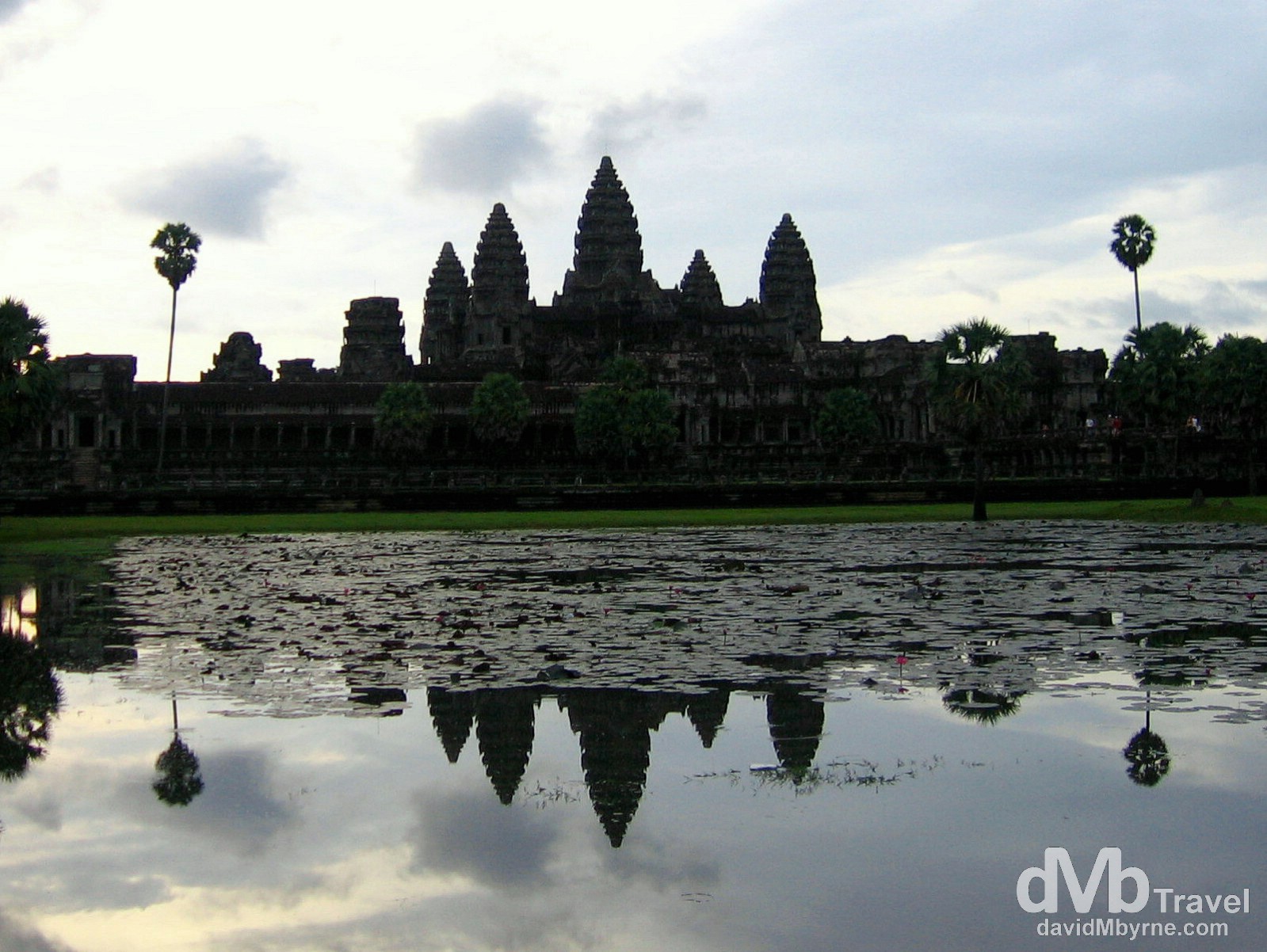Angkor
The Stunning Ancient Khmer Capital, Cambodia’s Greatest Treasure & The Highlight Of Any Trip To Southeast Asia
Approaching Angkor Wat, Angkor, Cambodia. September 20, 2005
Travellers have been compiling lists ever since Antipater of Sidon came up with his Seven Wonders of the World in the second century BC. On my own list of wonders no place would have a more secure claim than Angkor, the capital of the ancient Khmer kingdom of Southeast Asia. Occupying 400 km² of tropical forest near the present-day town of Siem Reap in northwestern Cambodia, the UNESCO World Heritage-listed archaeological district of Angkor consists of over 100 sculptured stone Buddhist or Hindu temples & other structures, the sacred remains of what was once a much larger administrative and religious centre.
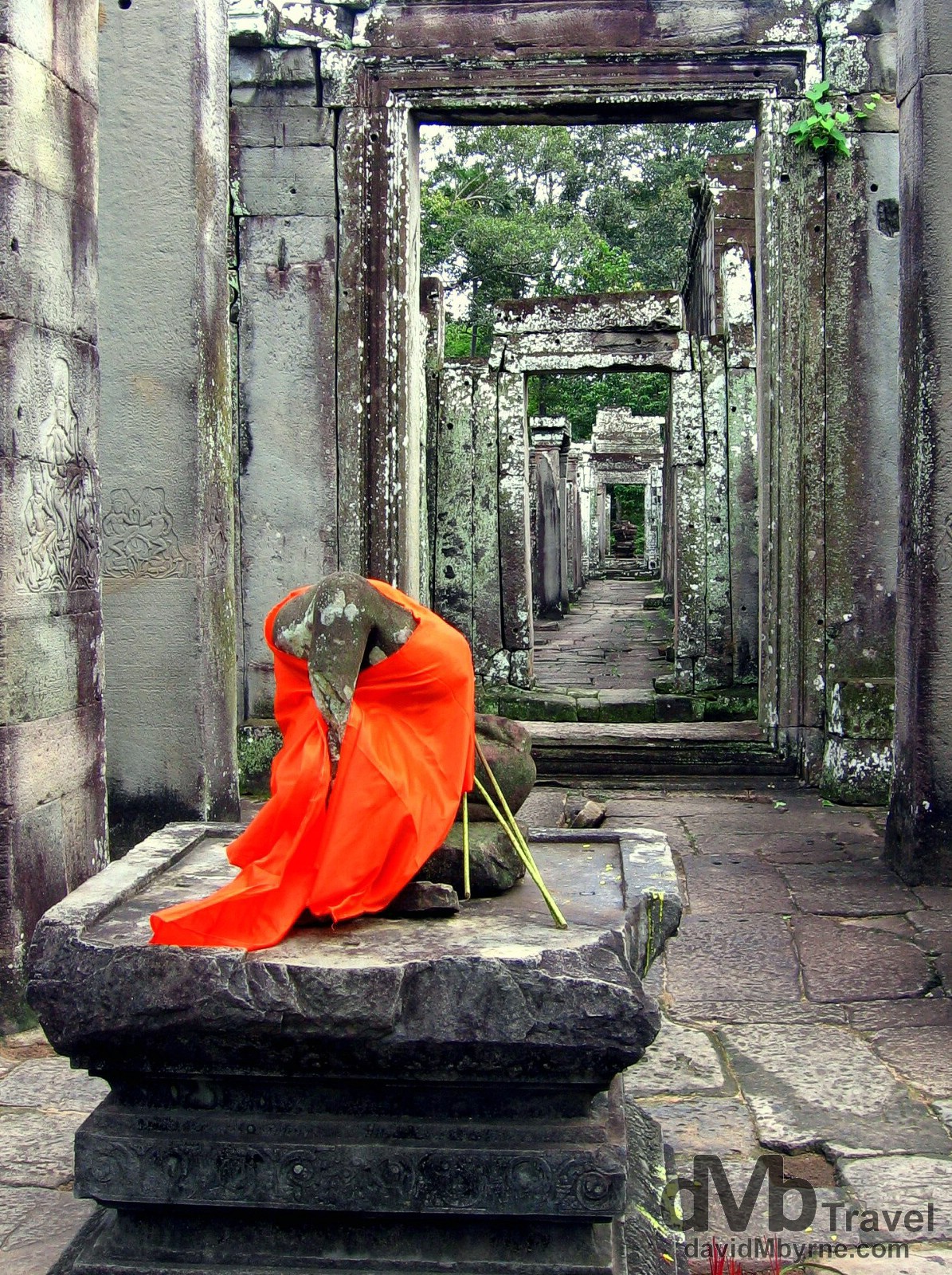
A headless Buddha in the ruins of the temples of Angkor, Cambodia. September 20, 2005.
Angkor || Then & Now
Built between the 9th and 13th centuries to glorify a succession of Khmer Kings, most of Angkor was abandoned in the 15th century allowing the temple structures to be gradually cloaked by forest. The site became the source of scholarly interest in the late 19th century after the publication of Voyage à Siam et dans le Cambodge by French naturalist & explorer Henri Mouhot. Shortly thereafter efforts were undertaken to clear away the jungle vegetation that threatened to completely destroy the monuments. Although structural support initiatives and restoration of the Angkor structures continue to this day, many of the temples are in a state of tumbledown disarray, long since snarled in jungle vegetation. Others are inaccessible because of uncleared land mines from the wars that devastated the region during the second half of the twentieth century. But dozens of temples, palaces, and other state buildings can now be safely and conveniently visited.
– Henri Mouhot
Angkor || The Return
I was unbelievably pumped to get back to Siem Reap – & Cambodia – because it meant I was going to once more explore the Angkor temples having first visited them in early 2003. The celebrated temples of Angkor are Cambodia’s greatest treasure, by far its biggest tourist draw &, in my opinion, the highlight of any trip to Southeast Asia. Hence the reason I was pumped to return; the highlight of my first visit to Southeast Asia in 2002-2003 was the day I spent exploring the Angkor temples, and likewise the highlight of this, my second visit to Southeast Asia, has been the day I’ve just spent getting reacquainted with the remnants of the old Khmer Kingdoms & the Khmer ingenuity – the artistic accomplishment and philosophical profundity of these monuments place the Khmer on a par with the most advanced civilizations of their time anywhere in the world. Familiarity did nothing to diminish the experience. Oh, and I also captured a few pictures this time around.
`
Angkor Wat || A 12th Century Architectural Masterpiece
Nowhere in Angkor is the Khmer ingenuity more apparent than at the biggest, most important & best preserved of the Angkor structures, stunning Angkor Wat.
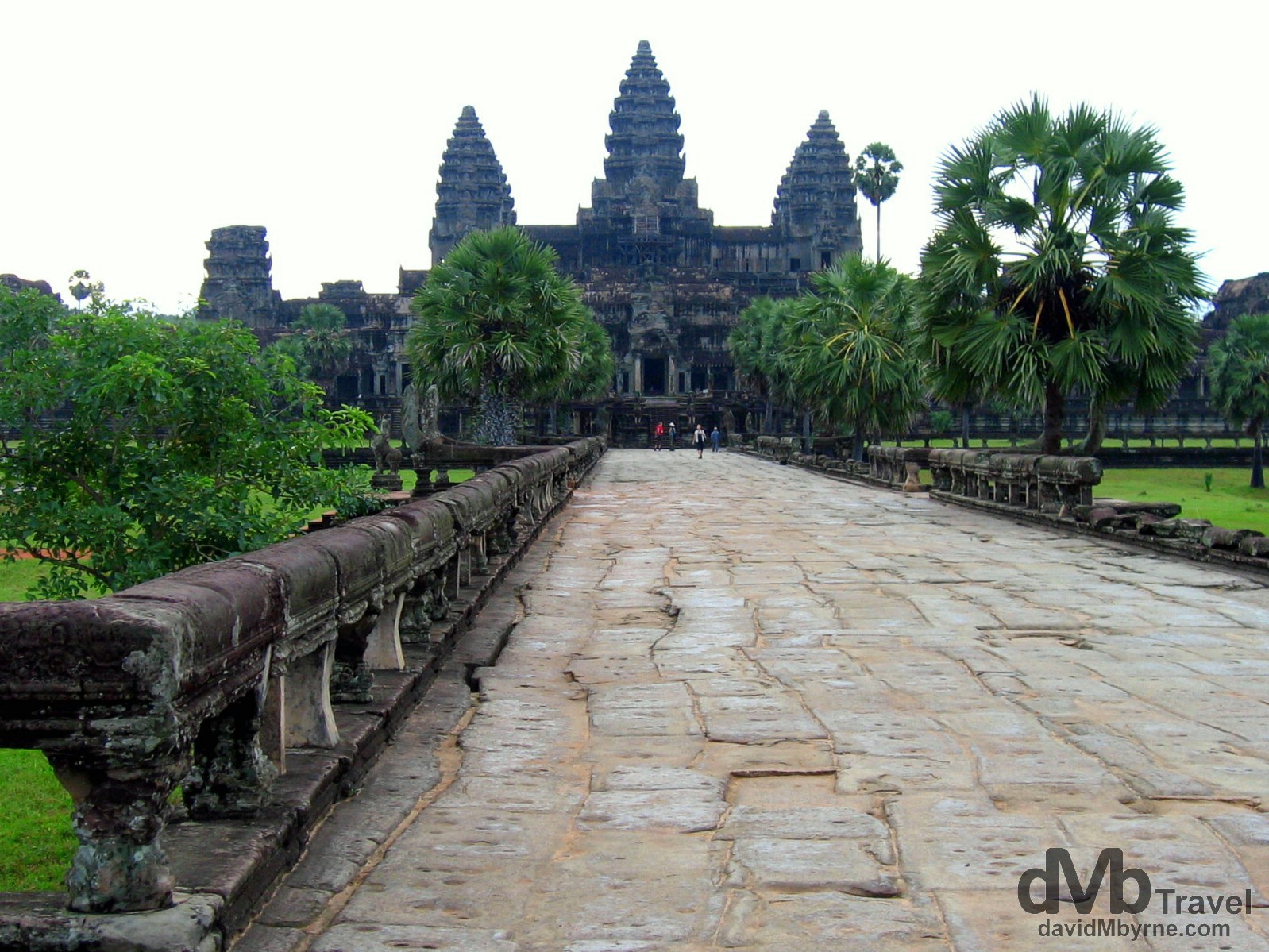
Most visits to Angkor are a full day affair, a temple loop starting at Angkor Wat for sunrise and ending at (most commonly) the temple Phnom Bakeng for sunset. And what a way to start the day. In its magnificence and state of preservation, Angkor Wat, the largest religious monument in the world & the largest and best preserved of all the Angkor temples, is unrivalled. An architectural masterpiece, its perfection in composition, balance, proportions, relief’s and sculpture make it one of the finest monuments in the world, a fact you cannot fail to appreciate when touring it. It was built by the Khmer King Suryavarman II (reign 1113-1150). It is estimated to have taken 30 years to build with construction finishing shortly after the King’s death. Scholarly opinions vary but it is generally accepted that it was built as a funerary temple for the King because it is oriented to the west, conforming to the symbolism between the setting sun and death. The amazing bas-reliefs (a mile and a half of detailed carvings in the walls surrounding the temple), designed for viewing from left to right in the order of Hindu funereal ritual, also support this function. The most famous relief, depicting a Hindu mythological scene called the “Churning of the Sea of Milk,” is a masterpiece of world art, a superbly balanced composition and a carving of exceptionally high quality. This picture was captured from the elevated walkway approaching the temple shortly after viewing a rather disappointing sunrise from the reflecting pool fronting the temple. An immensely popular sunrise location for all Angkor visitors, not just photographers, make sure you get there early to beat the hordes. Angkor, Cambodia. September 20, 2005.
Aside from Angkor Wat, there are many other magnificent temples to visit. Here’s my pick of what I saw today.
Angkor Thom & Bayon
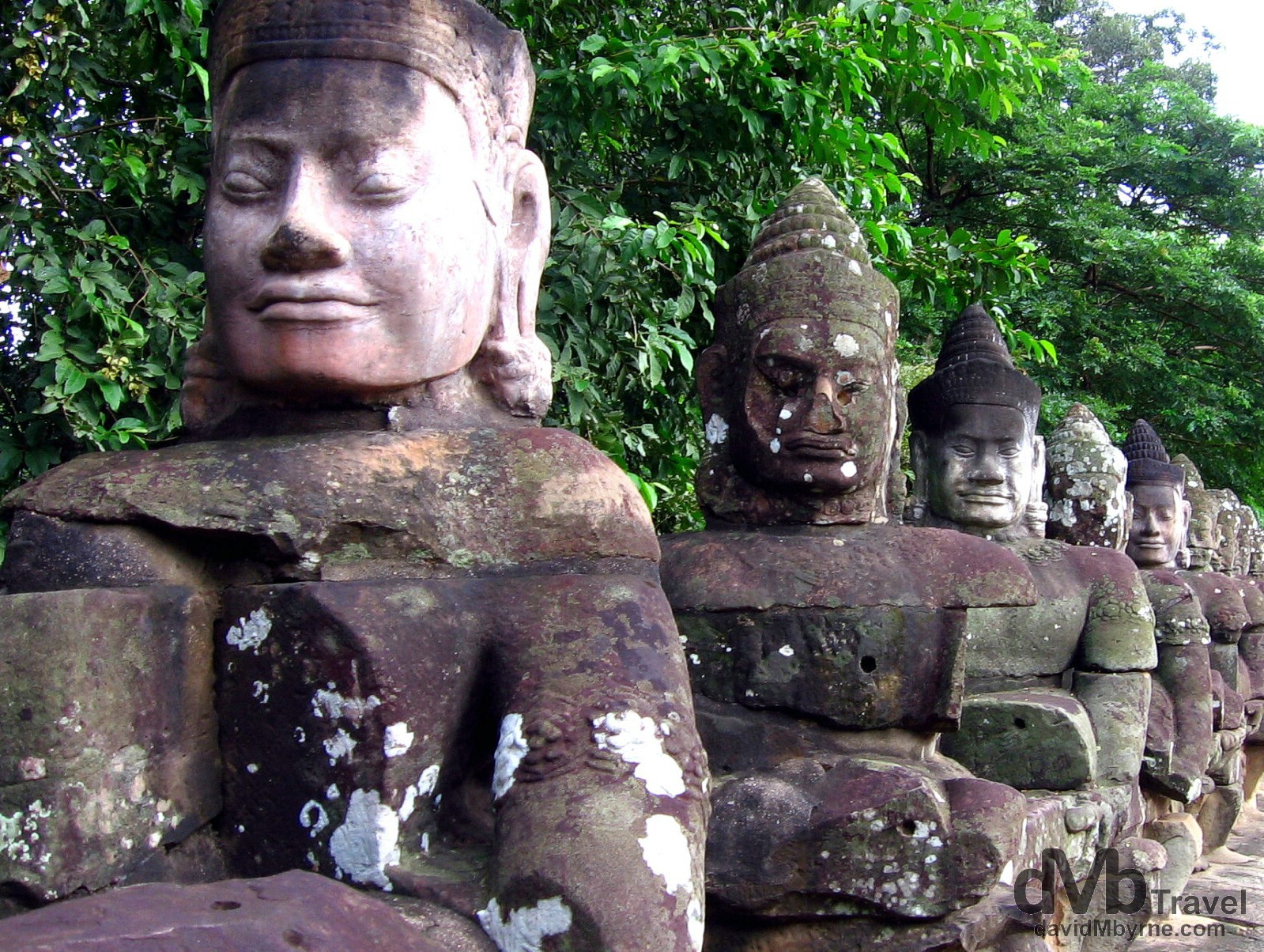
Guardians flanking the bridge leading to the south entrance of the walled city of Angkor Thom, the inner royal city located just north of Angkor Wat. It is a moated, walled city of nearly four square miles and was built by the end of the 12th century, during the reign of King Jayavarman VII. It was for centuries the Khmer empire’s seat of government – both its spiritual center and the site of the King’s palace (constructed of wood, this vanished centuries ago). On the bridge to the city’s main, south gate you’ll find these sculptures, depicting fifty-four Gods on one side (some of which are seen here) and the same number of demons on the other. Most of the figures are, not surprisingly, in a dilapidated state with some of them decapitated, their heads lopped off by looters. On the bridge to the south gate of Angkor Thom, Angkor, Cambodia. September 20, 2005.
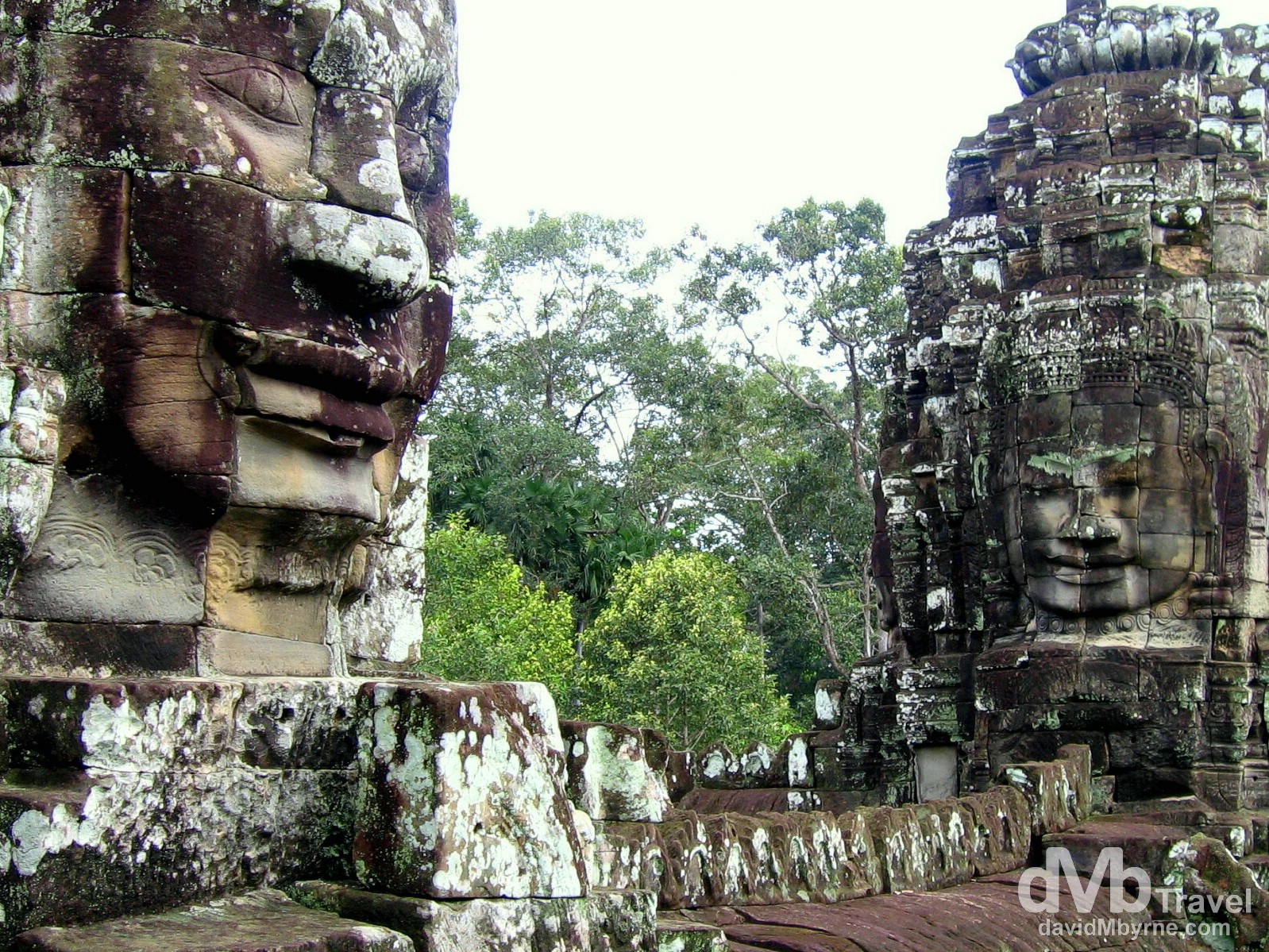
The distinctive faces of the temple Bayon, the undoubted highlight of the walled city Angkor Thom. Sitting at the city’s center, the Bayon is the oldest of Angkor Thom’s relics. The brooding sculptured-stone mountain is characterized by its many towers with four faces at the four cardinal points. It is the masterpiece of Jayavarman VII, the empire’s last great ruler. He was a fascinating character, almost a Khmer version of Napoleon. Before his rule the monuments of Angkor were Hindu but Jayavarman, for reasons that can only be speculated on, converted to Buddhism and embarked on a frenzied building spree to celebrate his new religion (and his reign) erecting a dozen major monuments in addition to the Bayon. In 1177, while Jayavarman was living abroad in exile, the Cham, the Khmer’s rivals to the east, invaded, burning and plundering the city. Four years later Jayavarman ascended to the throne, repelled the Cham invaders, and took their king hostage. He ruled until he died in 1219 at the age of ninety-five. While the temple to the untrained eye may look like nothing more that a jumble of rocks it, and the overall temple grounds, have puzzled archaeologists because they do not fit with the Hindu religion in the way Angkor Wat does. Therefore it is assumed that King Jayavarman VII introduced elements of the Buddhist faith into the religious system of Angkor, though it is assumed they were lost after his death. Bayon, Angkor Thom, Angkor, Cambodia. September 20, 2005.
Sarh Srang
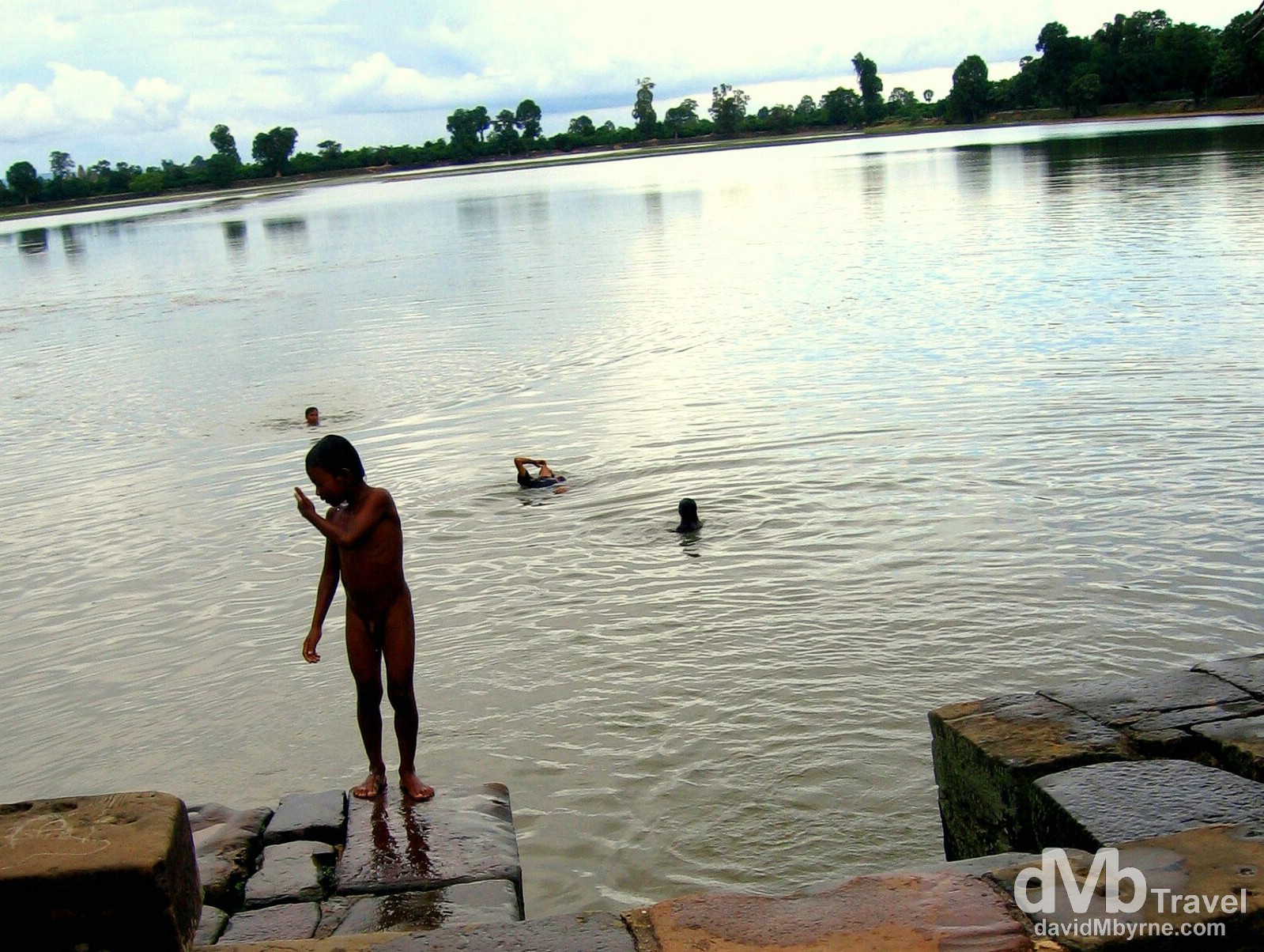
Children swimming in Srah Srang, the royal bath, a large lake (700m x 300m) with an elegant landing terrace of superb proportion and scale. It was built at the end of the 12th century as a Buddhist structure by King Jayavarman VII. It always has water, is surrounded by greenery and is, as with the aforementioned temple Phnom Bakeng, a popular location on the Angkor temple circuit for catching sunset. Srah Srang, Angkor, Cambodia. September 20, 2005.
Preah Khan
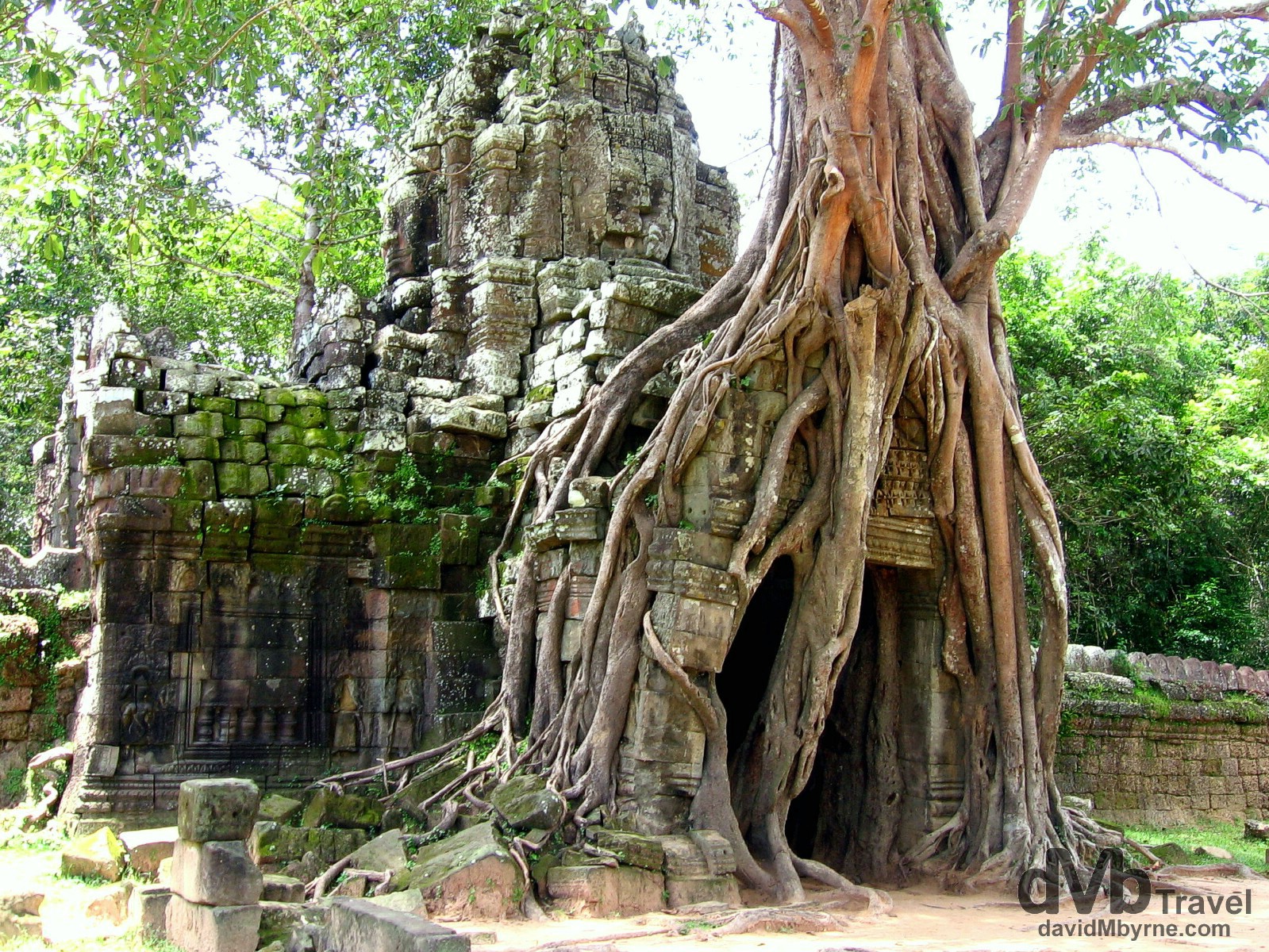
A tree smothers part of the temple Preah Khan. The amazing effects of the jungle encroaching on a temple structure can be seen on many of the Angkor temples, which where only discovered by the west after hundreds of years of local neglect. This temple was built by Jayavarman VII, the King responsible for the Bayon and whose name is on more Angkor temples than any other King. Some of the most beautiful buildings are the temples and monasteries Jayavarman built in the forest, outside the walls of Angkor Thom. This is one of them, Preah Khan. It is a huge monastery dedicated to the cult of Jayavarman’s father while another nearby temple, Ta Prohm (next picture), is similar in design but devoted to his mother. But Preah Khan was more than just a monastery – it was an entire city enclosing a town of 56 hectares. About 100,000 farmers produced rice to feed about 15,000 monks, teachers, and students. Subsidiary buildings included a hospital, rest house, and rice granary. Today this jungle temple is in a state of hopeless, fabulous disorder; the vines and roots of the luxuriant vegetation intertwining inextricably with the carved stone walls. It is being restored under the supervision of the World Monuments Fund, an independent non-profit organization, which has wisely decided to stabilize the present structure rather than to rebuild it, thus leaving the intricate mass of art and nature more or less as it was when discovered by the west. Preah Khan, Angkor, Cambodia. September 20, 2005.
Ta Prohm
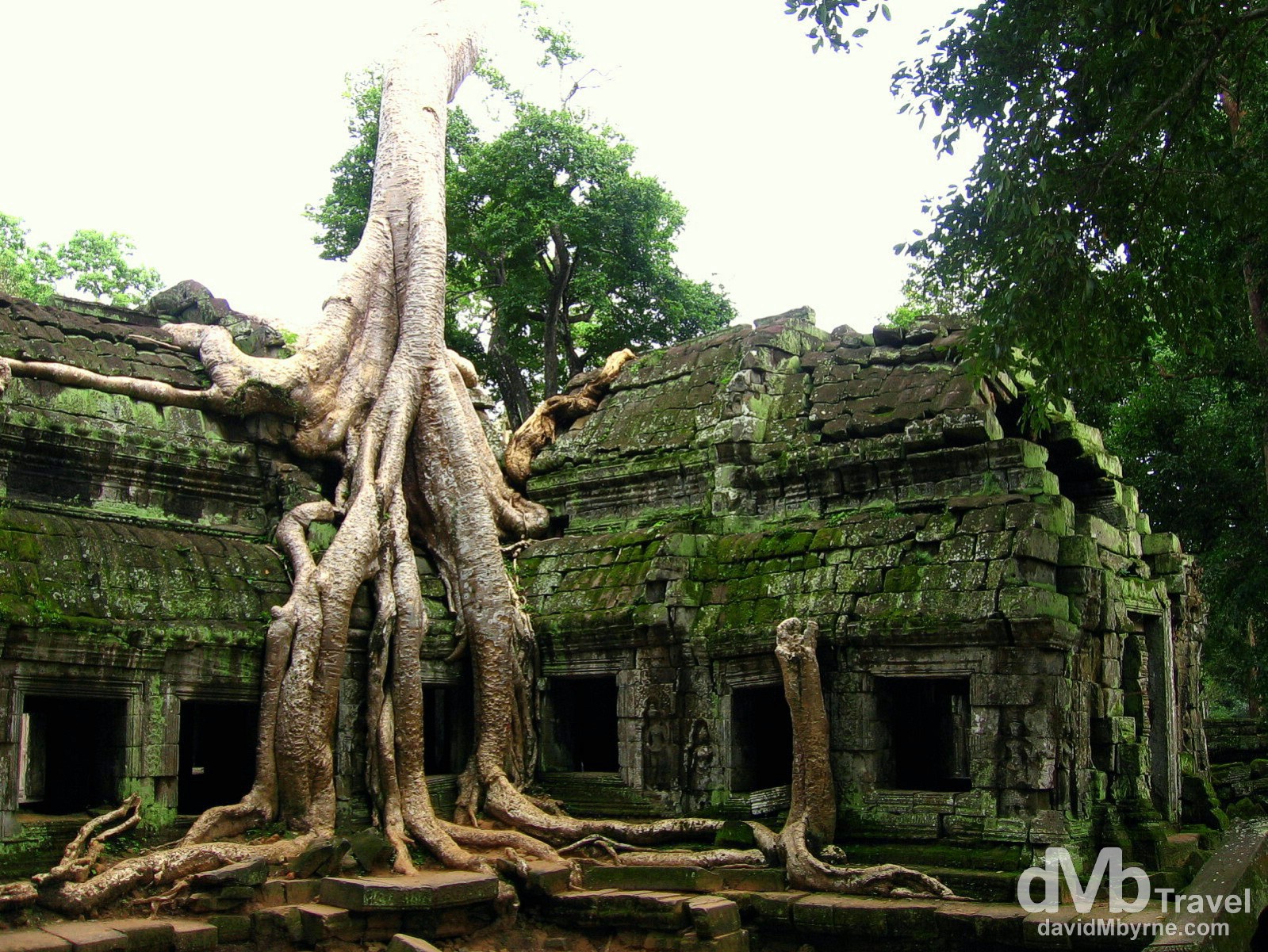
More jungle growth, this one enveloping a section of the temple Ta Prohm, probably the most photographed example of the jungle encroaching on the temple structures of Angkor. Unlike most of the Angkor temples, the temple Ta Prohm has been purposely left in a state of ruin except for the clearing of a path for visitors and structural strengthening to stave of further deterioration. Because of its natural state it is possible to experience here the wonder of the early explorers when they came upon these monuments in the middle of the 19th century. Built by Jayavarman VII as a monument to his rule, it served as a huge monastery and was dedicated to the cult of Jayavarman’s mother (Preah Khan, similar in design, was devoted to his father). Ta Prohm, Angkor, Cambodia. September 20, 2005.
– Maurice Glaizeobserved, Angkor scholar on Ta Prohm
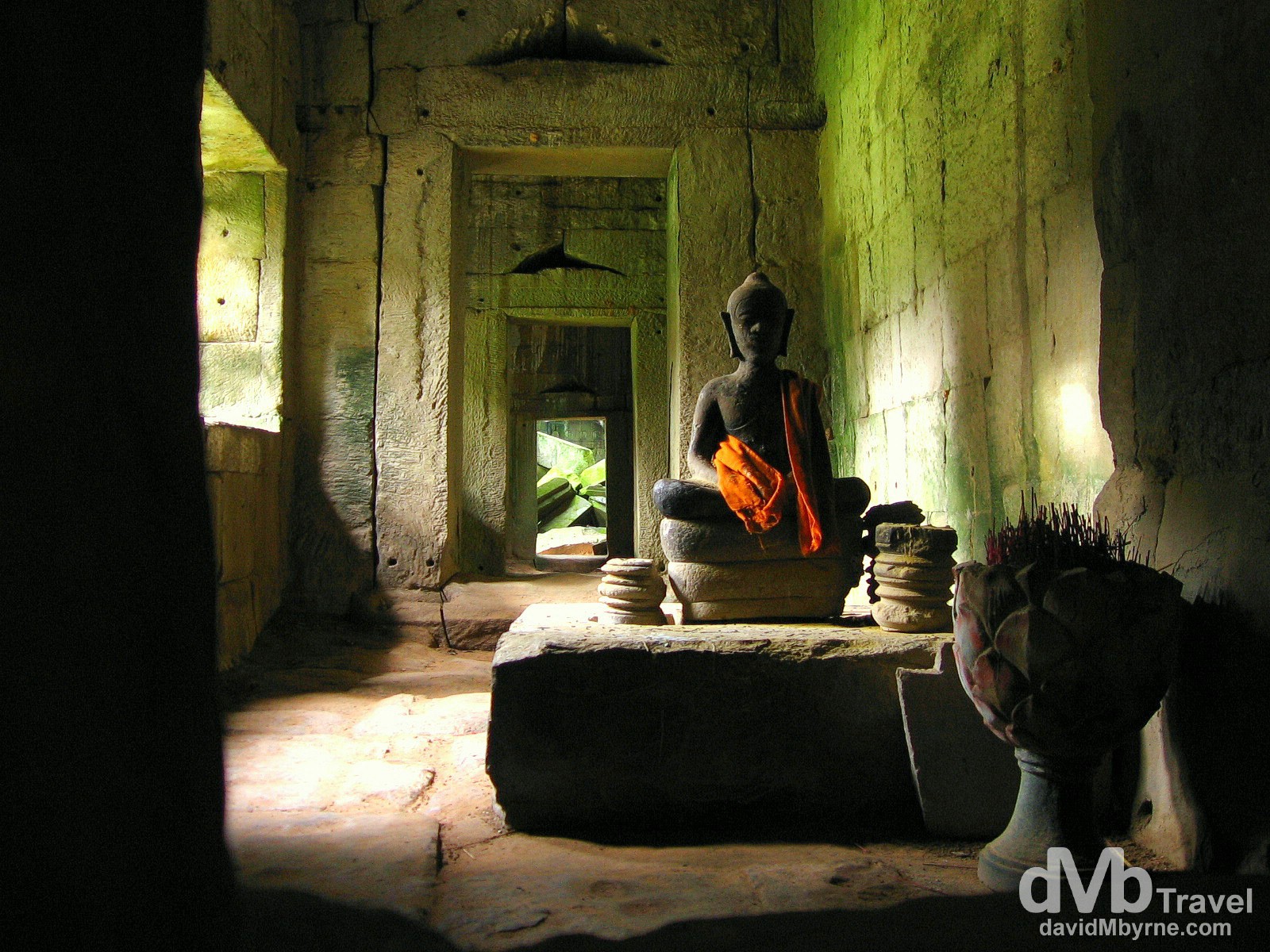
A small Buddha in the dark corridors of the monastery temple Ta Prohm. Angkor, Cambodia. September 20, 2005.

